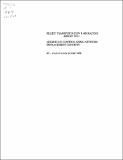| dc.contributor.author | Wei, Yuanyuan | en_US |
| dc.contributor.other | Massachusetts Institute of Technology. Flight Transportation Laboratory | en_US |
| dc.date.accessioned | 2012-01-06T22:46:42Z | |
| dc.date.available | 2012-01-06T22:46:42Z | |
| dc.date.issued | 1996 | en_US |
| dc.identifier | 663475202 | en_US |
| dc.identifier.uri | http://hdl.handle.net/1721.1/68150 | |
| dc.description | Cover title | en_US |
| dc.description | Includes bibliographical references (p. 120) | en_US |
| dc.description.abstract | In the airline industry, it is customary for carriers to offer a wide range of fares for any given seat in the same cabin on the same flight. In order to maximize the total network revenue, the airline practices so-called seat inventory control methods. In this thesis, we first examine several seat inventory control methods which are employed or are being developed by some airlines. Then, based on these methods, we propose three new models to control the seats: the Network Non-greedy Heuristic Bid Price model, the Leg Based Probability Non-greedy Bid Price Model, and the Convergence Model. These models are created in order to find a better way to evaluate the connecting fares, taking into consideration their displacement impacts. An integrated optimization / booking simulation tool is employed in this research to compare the new models with the other methods in terms of network performance under the same demand circumstances. Generally, all the three new models improve network performance. The revenue results obtained from the simulation show that using network displacement concepts can provide us with an average of 0.5% revenue gain over the methods that do not explicitly include the displacement impacts at a load factor of 93%. The simulation results also show that under the same demand circumstance and seat control strategies, using a better way to evaluate the displacement impacts can provide 0.05% revenue improvement. | en_US |
| dc.format.extent | 139 p | en_US |
| dc.publisher | [Cambridge, Mass. : Massachusetts Institute of Technology], Flight Transportation Laboratory, [1996] | en_US |
| dc.relation.ispartofseries | FTL report (Massachusetts Institute of Technology. Flight Transportation Laboratory) ; R97-1 | en_US |
| dc.subject | Airlines | en_US |
| dc.subject | Airplanes | en_US |
| dc.subject | Management | en_US |
| dc.subject | Seats | en_US |
| dc.subject | Rates | en_US |
| dc.title | Airline O-D control using network displacement concepts | en_US |
| dc.title.alternative | Airline Origin-Destination control using network displacement concepts | en_US |
| dc.type | Technical Report | en_US |
